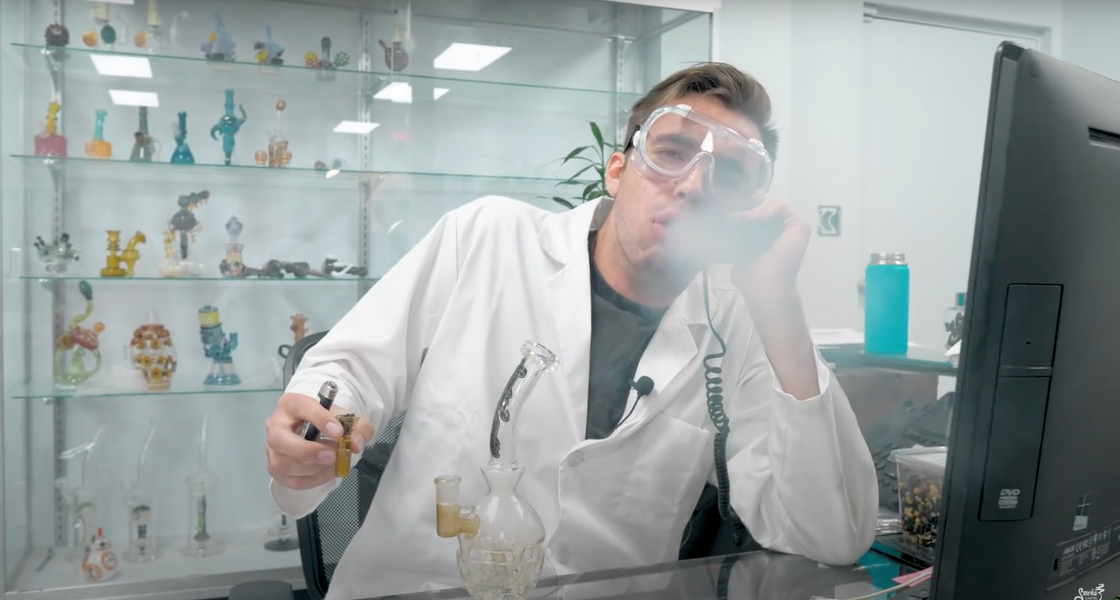Especially if you haven't taken a tolerance break in a while, the herb can get a bit routine. The more you ingest, smoke, or dab, the more you think-- how high COULD I possibly get?
The Short Answer

It's not so much about how much cannabis you can put into your brain-- it's more about how much can actually fit.
When you smoke weed, you're filling your brain with cannabinoid molecules. They're plugging into receptors in your endocannabinoid system.
But, you only have so many receptors. So, once they're all filled up, that's kind of it. They're all good and plugged.
Unfortunately, there's no cheat to avoiding building a tolerance to THC. If there was, believe me, we'd sell it. But, understanding how your body processes it could help you become the master of your own mind-- and how to get it as stoned as possible.
What is the Endocannabinoid System?

The endocannabinoid system, or ECS for short, is a biological system made of endocannabinoids (a special type of neurotransmitter) that bind to cannabinoid receptors. Every human body has this system. This system is usually associated with how we experience the psychoactive properties of cannabis consumption but that doesn’t really tell us the whole story.
ECS is possibly responsible for governing so much more in our bodies, including regulation of physiological and cognitive processes, appetite, fertility, mood, memory, pain-sensation, sleep, immune system activity and much more. Since its discovery in the 90s, scientists have come to understand ECS and its role a lot better and on deeper levels than just observing it as a mediator to pharmacological effects of cannabis consumption.
The system’s primary role is to maintain homeostasis. This is when we’re at peak performance and our body is in a well-balanced, regulated state. Humans are not the only species that have ECS. It’s also found in birds, fish, mammals, and reptiles. It regulates the same processes in basically all animals of the world.
ECS has three main components - endocannabinoids, cannabinoid receptors, and enzymes that break them down. These are present all throughout the body - in the bloodstream and lymph, the skin, organs, our brain, our nervous system - literally everywhere.
The Role of Cannabinoid Receptors
These receptors are what allows us to get that high feeling from cannabis consumption. In layman’s terms, cannabis goes directly from your lungs to the brain. And while that’s partly true, cannabis really goes into the bloodstream first and then passes the blood-brain barrier. Molecules of THC, CBD, and hundreds of other cannabinoids are welcomed by cannabinoid receptors.
Once these molecules are in the brain, they flood our ECS with signals that our body doesn’t naturally send via neurons. These neurons then stop sending neurotransmitters, which alters the normal flow of information among neurons and thus creates the feeling of being high. It might sound complicated, but it’s really simple - molecules found in cannabis (like THC) trick our brain and alter its functions for brief periods of time until they’re expelled from the body.
So How High Can I Possibly Get?

This is a lot tricker to answer as it depends on multiple factors. The first and most important to consider is the state of our receptors. They tend to work a bit better or worse, depending on how much cannabis you consume - just like most things in life.
If you flood your receptor with lots of weed on a regular basis, they will not be compromised but will show signs of working less than optimally. A balanced approach is key here. Thankfully, it only takes about 2-3 days for the receptors to reset to optimal levels.
The other factors to consider include consumption method, dosage, potency, variety of cannabinoids present, the strain of weed, and your individual tolerance levels.
You can smoke, vape, eat, and drink cannabis. All of these consumption methods will produce different results for different people. Some of us are pretty tolerant to an everyday doobie or two, while others might get blazed to oblivion. Same can be said about edibles, for example.
The weed strain you ingest will have its own markup of cannabinoids. This will heavily influence your high because of the entourage effect. This effect is what is caused by multiple molecules like THC, CBD, CBG and others working together in unison. The more cannabinoids present in your weed, the better and more potent it is.
All of these factors are important but not as much as your own tolerance levels. This also answers our question in a scientific manner, too. Scientists have not yet broken down the ‘euphoria’ behind the high you get from weed, but all of them agree that the level of it entirely depends on the individual and his or her history with cannabis consumption.
The more you use cannabis, the more tolerant your body becomes. You are the key that opens the door and answers the question of how high can you possibly get. Each and every individual is different and will certainly have a ‘the highest I ever was’ story to tell. And science will back them up.





























